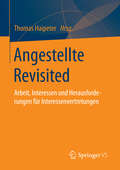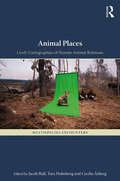- Table View
- List View
Angestellte Revisited: Arbeit, Interessen und Herausforderungen für Interessenvertretungen
by Thomas HaipeterDas Buch nimmt die interne Tertiarisierung der Industrie in den Blick und untersucht die Beschäftigtengruppe der Angestellten. Ingenieure und Techniker sowie Kaufleute und Bürokräfte stellen inzwischen einen höheren Beschäftigtenanteil als die Arbeiter, die bislang das Bild der Industrie geprägt haben. Angestellte nehmen mit ihren technischen und betriebswirtschaftlichen Qualifikationen Schlüsselpositionen in den Unternehmen ein. Sie wollen zum Unternehmenserfolg beitragen und arbeiten dafür überdurchschnittlich lange und mit wachsender Intensität. Zugleich rücken die Angestellten heute mehr als zuvor in den Blickpunkt der betrieblichen und gewerkschaftlichen Interessenvertretungen. Denn ohne Legitimation durch die Angestellten und ohne Organisierung ihrer Interessen würde kollektive Interessenvertretung in der Industrie zu einer exklusiven Politik für die langsam aussterbende Minderheit der Industriearbeiter und zunehmend an Macht und Einfluss verlieren.
Angestellte als Machtquelle: Neue Initiativen der Interessenvertretung von Industrieangestellten im Betrieb
by Thomas Haipeter Tabea Bromberg Christine SlomkaDer Band befasst sich mit den gewandelten Aufgaben der Industriegewerkschaften in einem ver#65533;nderten Arbeitsumfeld. Die Organisationsmacht von Gewerkschaften und Betriebsr#65533;ten in Industriebetrieben gr#65533;ndet sich auf ihre starke Verankerung bei den Industriearbeitern. Dieses Besch#65533;ftigtensegment aber schrumpft, und die Machtquellen der Interessenvertretungen im Industriesektor drohen zu versiegen. Die Interessenvertretungen k#65533;nnen Macht und Einfluss in der Tarif- und Betriebspolitik zuk#65533;nftig nur erhalten, wenn sie ihre Organisierung bei den Angestellten verbessern, deren Anteil an den Besch#65533;ftigten inzwischen ebenso hoch ist wie derjenige der Arbeiter. Dies gilt umso mehr, als diese Besch#65533;ftigtengruppen in den Betrieben typischerweise ein hohes Machtpotenzial aufweisen, sei es, weil sie #65533;ber knappe Qualifikationen verf#65533;gen oder sei es, weil sie wichtige fachliche oder autorit#65533;re Positionen in den betrieblichen Hierarchien einnehmen.
Angewandte Ethik und Technikbewertung: Ein methodischer Grundriss – Grundlagen der Technikethik Band 2
by Michael FunkWie bilde ich mir ein ethisches Urteil, um Konflikten zu begegnen? Was ist Technik und wer ist verantwortlich, wenn sie versagt? Stehen Menschen noch im Mittelpunkt – obwohl oder gerade weil Maschinen immer „smarter“ werden? Fragen wie diese verlangen nach einer übersichtlichen und verständlichen Präsentation ethischer Methoden der Technikbewertung. Dabei rückt vorliegendes Buch die Auseinandersetzung mit den Folgen, Risiken und Nebeneffekten technischen Handelns in den Mittelpunkt. Diese reichen von ökologischen Fragen der Entsorgung über Zweckentfremdung bis hin zur individuellen und kollektiven Verantwortung von Ingenieur*innen. Aufbauend auf Grundlagen der angewandten Ethik wird in Bottom-up- und Top-down-Verfahren die Kasuistik sowie analogisch-vergleichende und logisch-ableitende Urteilsbildung eingeführt. Wesentliche Charakteristika technischen Handelns sowie Akteursrollen werden systematisch vorgestellt. Abbildungen, Beispiele und Aufgaben runden den verständlichen Aufbau ab. Als methodischer Grundriss richtet sich vorliegendes Buch an Ingenieurwissenschaftler*innen, Informatiker*innen und Geisteswissenschaftler*innen im Berufsalltag, aber auch an interessierte Lai*innen, die mehr über ethische Praxis erfahren wollen. Es bildet den zweiten, in sich abgerundeten Teil der Buchreihe Grundlagen der Technikethik.Haben wir die Technik, die wir brauchen, und brauchen wir die Technik, die wir haben?
Angewandte Improvisation für Coaches und Führungskräfte: Grundlagen und kreativitätsfördernde Methoden für lebendige Zusammenarbeit
by Susanne Schinko-FischliDieses Fachbuch zeigt theoretisch und praktisch auf, wie sich kreativitätsfördernde Methoden aus der Angewandten Improvisation strukturiert in der Teamarbeit einsetzen und damit lebendige Zusammenarbeit und Innovation in Gruppen und Unternehmen gezielt fördern lassen: Durch das prinzipielle Annehmen und Erweitern von Ideen und Angeboten werden kreative Impulse nicht blockiert, sondern in die tägliche Zusammenarbeit integriert. Anhand zahlreicher Übungen werden verschiedene allgemeine und spezielle Methoden (u.a. zur Ko-Kreativität, Storytelling und Status) praxisnah für den Einsatz in Trainings, Teamarbeit und Führungshandeln vorgestellt.
Angewandte Improvisation für Coaches und Führungskräfte: Grundlagen und kreativitätsfördernde Methoden für lebendige Zusammenarbeit
by Susanne Schinko-FischliDieses Fachbuch zeigt theoretisch und praktisch auf, wie sich kreativitätsfördernde Methoden aus der Angewandten Improvisation strukturiert in der Teamarbeit einsetzen und damit lebendige Zusammenarbeit und Innovation in Gruppen und Unternehmen gezielt fördern lassen: Durch das prinzipielle Annehmen und Erweitern von Ideen und Angeboten werden kreative Impulse nicht blockiert, sondern in die tägliche Zusammenarbeit integriert. Anhand zahlreicher Übungen werden verschiedene allgemeine und spezielle Methoden (u.a. zur Ko-Kreativität, Storytelling und Status) praxisnah für den Einsatz in Trainings, Teamarbeit und Führungshandeln vorgestellt.
Angewandte Psychologie für das Human Resource Management. Konzepte und Instrumente für ein wirkungsvolles Personalmanagement: Konzepte Und Instrumente Für Ein Wirkungsvolles Personalmanagement
by Birgit Werkmann-Karcher Jack RietikerAuch wenn Personalmanager keine Psychologen sein müssen, was sie tun, ist angewandte Psychologie: u. a. Menschen und ihre Rollen im Unternehmen verstehen und beeinflussen, Wandel in Organisationen gestalten. Dafür kann die Kenntnis psychologischer Instrumente und Theorien sehr hilfreich sein. Dieser Leitfaden basiert auf einer Weiterbildung für Personalmanager am Institut für Angewandte Psychologie (Zürich) und beleuchtet aktuelle Themen wie z. B. Talent-, Performance- und Demografie-Mangement - mit zahlreichen Tipps, Checklisten und Fallbeispielen.
Angewandte Psychologie für das Projektmanagement: Ein Praxisbuch für die erfolgreiche Projektleitung
by Michael A. West Monika Wastian Isabell Braumandl Lutz Von RosenstielProjektmanagement ist mehr als nur planen und organisieren: Personen führen, mit Konflikten und Krisen umgehen, kommunizieren, Meinungsbildung und Projektumfeld steuern, die Identifikation der Mitarbeiter fördern, Wissen und Kreativität managen. Worauf es dabei ankommt, erklären in dem Handbuch erfahrene Psychologen und Experten aus der Projektmanagement-Praxis: Ausgehend von typischen Problemen aus dem Projektalltag werden psychologische Hintergründe erläutert und Lösungen präsentiert. Mit Tipps zum Selbstmanagement, Fallbeispielen und Checklisten.
Angewandte Psychologie für die Personalentwicklung. Konzepte und Methoden für Bildungsmanagement, betriebliche Aus- und Weiterbildung: Konzepte Und Methoden Für Bildungsmanagement, Betriebliche Aus- Und Weiterbildung
by Christoph NegriIn Zeiten rasanter Veränderungen in Organisationen und der Wirtschaft insgesamt sind auch Bildungsfachleute und Personalentwickler gefordert, ihre Kernaufgaben neu zu definieren. Dazu bietet die angewandte Psychologie einen Orientierungsrahmen. In dem Band vermitteln Praktiker die psychologischen Grundlagen für eine moderne, nachhaltige betriebliche Bildungsarbeit und Personalentwicklung. Dabei greifen sie auch aktuelle Themen wie E-Learning, erlebnisorientiertes Lernen, Bildungsmarketing, Performance Management oder Corporate Learning auf.
Angewandte Psychologie für die Wirtschaft: Arbeit – Konsum – Gesellschaft
by Jörn Basel Sylvia Manchen SpörriLehrbuch zur angewandten Psychologie in der Wirtschaft mit den Schwerpunkten Arbeit, Konsum und Gesellschaft Wirtschaft und Gesellschaft werden durch Megatrends wie digitale Transformation, nachhaltige Entwicklung, demografischen Wandel und weltweite Krisen herausgefordert. Dieses wirtschaftspsychologische Lehrbuch stellt den Menschen in den Mittelpunkt dieser Dynamik und bietet einen anwendungsbezogenen Einblick in die drei zentralen Bereiche: 1.) Arbeit und Organisation 2.) Konsum und Markt sowie 3.) Kapital und Gesellschaft Klar strukturiert und didaktisch ansprechend bietet es einen gut verständlichen und praxisorientierten Überblick zu wirtschaftspsychologischen Themen wie: Generationen-übergreifendes Management, Freiwilligenarbeit, Zukunft der Arbeit und künstliche Intelligenz, New Work, digitale Transformation, Führung von virtuellen und hybriden Teams, Führung und Nachhaltigkeit, Future Skills undMythen der Personalauswahl Konsumentenverhalten im Mehrkanalhandel, Kundenvertrauen und Misstrauen, Nachhaltiger Konsum, User und Customer Experience, nachhaltiges Mobilitätsverhalten Gestaltung von Anreizsystemen und Experimentability, Corporate Social Responsibility, das Verhältnis von Gemeinsinn und Eigennutz, verhaltensorientierte Wirtschaftsethik Dazu erhalten Sie digitale Zusatzmaterialien. Zu den Zielgruppen: Studierende der Wirtschaftspsychologie und anderer Studiengänge im Bereich Wirtschaft, Teilnehmende von Weiterbildungen, Entscheidungsträger, Führungskräfte und alle, die sich für aktuelle Herausforderungen für Wirtschaft und Gesellschaft interessieren. Zu den Herausgebern: Prof. Dr. Jörn Basel, Professor für Wirtschaftspsychologie an der Hochschule Luzern (HSLU). Mitglied des First International Network on Trust (FINT). Seine Forschung beschäftigt sich unter anderem damit, wie Organisationen verlorenes Vertrauen wiederaufbauen können und wie erfolgreiche Verhandlungen gelingen können. Prof. Dr. Sylvia Manchen Spörri, Professorin für Wirtschaftspsychologie an der Hochschule Luzern (HSLU). Mitglied der Schweizerischen Gesellschaft für Arbeits- und Organisationspsychologie. Mitbegründerin des Bachelorstudiengangs Business Psychology, Forschung im Bereich Führung, Diversity und Nachhaltigkeit, Mentorin und Coach.
Angewandte Psychologie in der Arbeitswelt (Der Mensch im Unternehmen: Impulse für Fach- und Führungskräfte)
by Daniela Eberhardt Christoph NegriDieser Band bietet einen brillanten und gut gewählten Mix, eine Art "Best-off-Zusammenstellung" zu den vielfältigen Themen des IAP Impuls aus der Breite und Vielfalt der Angewandten Psychologie.Sie erhalten somit aktuelles, kompaktes Wissen und interessante und konkrete Praxisbeispiele zu den folgenden, in der Arbeitswelt 4.0 sehr wichtigen und relevanten Themenbereichen:Führung in der Arbeitswelt 4.0TeamarbeitUnternehmertumChange-ManagementDiversityDigitalisierung, KI Zielgruppen: Fach- und Führungskräfte, Geschäftsführer/-innen, Personalentwickler/-innen, HR-Manager/-innen, Berater/-innen und alle an den Entwicklungen der Arbeitswelt 4.0 interessierten Personen.Zu den Herausgebern: Prof. Dr. Christoph Negri ist Leiter des IAP Institut für Angewandte Psychologie an der ZHAW Zürcher Hochschule für Angewandte Wissenschaften. Seit 2015 führt er am IAP verstärkt neue Entwicklungen im Bereich Lernen und Lehren ein und treibt den digitalen Wandel in Weiterbildung und Dienstleistung voran.Prof. Dr. Daniela Eberhardt ist Direktorin Human Resources Management der Stadt Zürich und war davor langjährige Leiterin des IAP Institut für Angewandte Psychologie an der ZHAW Zürcher Hochschule für Angewandte Wissenschaften.
Angewandte Psychologie: Beiträge zu einer menschenwürdigen Gesellschaft (Der\mensch Im Unternehmen: Impulse Für Fach- Und Führungskräfte Ser.)
by Christoph Negri Daniel SüssDieses aktuelle und zukunftsweisende Fachbuch zeigt aus einer Perspektive der humanistischen und positiven Psychologie auf, welche Beiträge die Angewandte Psychologie zu einer humanen und nachhaltigen Gesellschaft leisten kann. Denn menschenwürdig ist eine Gesellschaft dann, wenn Menschen darin aufblühen können, Organisationen und Institutionen immer auch dem Gemeinwohl dienen und die natürlichen Ressourcen nachhaltig gepflegt werden. Gleichzeitig dient dieses Werk als Festschrift zum 60. Geburtstag von Prof. Dr. Christoph Steinebach. Zielgruppen: Professionals und an dieser Thematik interessierte Laien. Zu den Herausgebern: Prof. Dr. Daniel Süss ist Leiter des Psychologischen Instituts, und Prof. Dr. Christoph Negri ist Leiter des IAP Institut für Angewandte Psychologie an der ZHAW - Zürcher Hochschule für Angewandte Wissenschaften.
Anglophilia: Deference, Devotion and Antebellum America
by Elisa TamarkinAnglophilia charts the phenomenon of the love of Britain that emerged after the Revolution and remains in the character of U.S. society and class, the style of academic life, and the idea of American intellectualism. But as Tamarkin shows, this Anglophilia was more than just an elite nostalgia; it was popular devotion that made reverence for British tradition instrumental to the psychological innovations of democracy. Anglophilia spoke to fantasies of cultural belonging, polite sociability, and, finally, deference itself as an affective practice within egalitarian politics. Tamarkin traces the wide-ranging effects of Anglophilia on American literature, art and intellectual life in the early nineteenth century, as well as its influence in arguments against slavery, in the politics of Union, and in the dialectics of liberty and loyalty before the civil war. By working beyond narratives of British influence, Tamarkin highlights a more intricate culture of American response, one that included Whig elites, college students, radical democrats, urban immigrants, and African Americans. Ultimately, Anglophila argues that that the love of Britain was not simply a fetish or form of shame--a release from the burdens of American culture--but an anachronistic structure of attachment in which U.S. Identity was lived in other languages of national expression.
Angloscene: Compromised Personhood in Afro-Chinese Translations
by Jay Ke-SchutteA free ebook version of this title is available through Luminos, University of California Press’s Open Access publishing program. Visit www.luminosoa.org to learn more.Angloscene examines Afro-Chinese interactions within Beijing's aspirationally cosmopolitan student class. Jay Ke-Schutte explores the ways in which many contemporary interactions between Chinese and African university students are mediated through complex intersectional relationships with whiteness, the English language, and cosmopolitan aspiration. At the heart of these tensions, a question persistently emerges: How does English become more than a language—and whiteness more than a race? Engaging in this inquiry, Ke-Schutte explores twenty-first century Afro-Chinese encounters as translational events that diagram the discursive contours of a changing transnational political order—one that will certainly be shaped by African and Chinese relations.
Angry White Men
by Michael Kimmel"[W]e can't come off as a bunch of angry white men. ” Robert Bennett, chairman of the Ohio Republican Party One of the enduring legacies of the 2012 Presidential campaign was the demise of the white American male voter as a dominant force in the political landscape. On election night, after Obama was announced the winner, a distressed Bill O’Reilly lamented that he didn’t live in "a traditional America anymore. ” He was joined by others who bellowed their grief on the talk radio airwaves, the traditional redoubt of angry white men. Why were they so angry? Sociologist Michael Kimmel, one of the leading writers on men and masculinity in the world today, has spent hundreds of hours in the company of America’s angry white men - from white supremacists to men's rights activists to young students -in pursuit of an answer. Angry White Men presents a comprehensive diagnosis of their fears, anxieties, and rage. Kimmel locates this increase in anger in the seismic economic, social and political shifts that have so transformed the American landscape. Downward mobility, increased racial and gender equality, and a tenacious clinging to an anachronistic ideology of masculinity has left many men feeling betrayed and bewildered. Raised to expect unparalleled social and economic privilege, white men are suffering today from what Kimmel calls "aggrieved entitlement": a sense that those benefits that white men believed were their due have been snatched away from them. Angry White Men discusses, among others, the sons of small town America, scarred by underemployment and wage stagnation. When America’s white men feel they’ve lived their lives the 'right’ way - worked hard and stayed out of trouble - and still do not get economic rewards, then they have to blame somebody else. Even more terrifying is the phenomenon of angry young boys. School shootings in the United States are not just the work of "misguided youth” or "troubled teens”--they’re all committed by boys. These alienated young men are transformed into mass murderers by a sense that using violence against others is their right. The future of America is more inclusive and diverse. The choice for angry white men is not whether or not they can stem the tide of history: they cannot. Their choice is whether or not they will be dragged kicking and screaming into that inevitable future, or whether they will walk openly and honorably - far happier and healthier incidentally - alongside those they’ve spent so long trying to exclude.
Angst in Kultur und Politik der Gegenwart: Beiträge zu einer Gesellschaftswissenschaft der Angst (Kulturelle Figurationen: Artefakte, Praktiken, Fiktionen)
by Susanne Martin Thomas LinpinselAngst ist nicht nur eine menschliche Grundemotion, sondern ein gesellschaftliches Phänomen. Jüngst wurde sie zum charakteristischen Gefühl westlicher Gegenwartsgesellschaften erklärt und insbesondere mit politisch regressiven Entwicklungen, allen voran dem Aufstieg des Rechtspopulismus, in Verbindung gebracht. Ausgehend von Befunden eines aktuell veränderten gesellschaftlichen Stellenwerts der Angst untersucht der Sammelband in interdisziplinärer Perspektive gegenwärtige Ursachen, Auswirkungen, Repräsentationen, Ausprägungen, Deutungen und Praktiken der Angst. Mithilfe unterschiedlicher konzeptueller, theoretischer und methodisch-empirischer Zugänge werden im Sinne einer interdisziplinären Gesellschaftswissenschaft der Angst die vielfältigen sozialen, politischen und kulturellen Bedeutungen der Angst in gegenwärtigen Gesellschaften beleuchtet.
Angst in Organisationen – mit emotionaler Authentizität zum Führungserfolg: Ein psychodynamischer Reader für Führungskräfte, Coaches und Coaching-Verantwortliche (essentials)
by Eva-Maria Lewkowicz Beate West-Leuer Marius NeukomUnliebsame Gefühle sind Merkmale konstruktiv authentischen Führens. Führungskräfte, die Angst erleben und reflektieren können, verfügen über Vorteile. Denn Angst ist nicht nur ein Schlüssel zur Ausbildung von Selbstkenntnis, sondern auch zur Förderung von Motivation, Zusammenarbeit und Veränderungsbereitschaft. In der Arbeitswelt wird Angst jedoch vermieden und tabuisiert, weil sie Abneigung erzeugt und als hemmend erlebt wird. Dieser Leitfaden macht dieses essenziell menschliche Gefühl zugänglich, erläutert seine unvermeidliche, gesunde wie auch krank machende Seite und zeigt Wege auf, wie es sinnvoll und produktiv in Führungsarbeit und Organisationsentwicklung integriert werden kann.
Angst und Angstpolitik: Interdisziplinäre Perspektiven (Studien zur Inneren Sicherheit)
by Jens Lanfer Martin W. SchnellDieses Buch untersucht das Phänomen der gesellschaftlichen Angst und die hierauf ausgerichtete Angstpolitik. Die Angst in der Gesellschaft wird von vielen sozialwissenschaftlichen Untersuchungen angeführt, bleibt aber theoretisch und vor allem analytisch auffällig unbestimmt. Dies gilt ebenso für gesellschaftliche Diskurse: Ob nun alltägliche Unsicherheiten oder die Furcht, Sorge oder Angst gemeint sind, bleibt entweder unklar oder die Begriffe werden synonym verwendet. Das Buch setzt sich deshalb zum Ziel, verschiedene Formen der Unsicherheit in der Gesellschaft deutlicher zu bezeichnen, um soziale und politische Bedingungen und Folgen von Angst genauer fassen zu können. Die Beiträge der Autor*innen reflektieren aus unterschiedlichen Disziplinen (Geschichtswissenschaft, Philosophie, Politikwissenschaft, Soziologie) und über verschiedene Anwendungsgebiete der Sicherheitspolitik das Angstphänomen. Das Buch richtet sich an Forscher*innen, die das Phänomen der gesellschaftlichen Angst theoretisch, analytisch und empirisch untersuchen möchten.
Angustias de un pez-volador
by Pedro MarangoniEl más patético de los animales, el Hombre-pez-volador, en este salto de un segundo de consciencia transitoria colecciona todo lo que puede acopiar, plumas al viento, granos de polvo, alguna hoja que quizás esté flotando en la superficie. Se tropieza con el pez que salta al lado, toma la iniciativa. Y después se disuelve en el agua con algunas salpicaduras que rápidamente desaparecen. Si en el micro momento antes de tocar con la cabeza el océano de la Nada, preguntáramos el color del maravilloso cielo que acababa de recorrer, no sabría la respuesta... ... Transitoriedad es la palabra que mejor definía a Arturo, porque así se sentía: un ser pasando de una forma a otra. Viajando como un pez-volador que había nacido cuando comenzaba a salir del agua para su salto y que, momentos después, caería nuevamente en la inconsciencia cuando volviera a tocar la superficie límpida, tranquila, indiferente de un mar infinito llamado Universo. Sabía que en esta reentrada por más que se agitara, sólo provocaría algunas salpicaduras que pronto desaparecerían.
Angustie di un pesce volante
by Pedro Marangoni Federico JorioIl più patetico tra gli animali, l’Uomo-pesce volante, in questo salto di un secondo di coscienza transitoria colleziona tutto quanto può racimolare, piume di penna al vento, granelli di polvere, foglie che, casualmente, galleggiasse sulla superficie. Si lancia sul pesce che salta al suo fianco, prendendo l’iniziativa. E dopo scompare in mare, creando schizzi che rapidamente si dissolvono. Se, nel micro momento prima che la testa impatti con l’oceano del Nulla, gli domandassimo il colore del meraviglioso cielo che ha appena terminato di percorrere, non conoscerebbe la risposta…Transitorietà è la parola che ben definiva Arthur, perché si sentiva così: un essere che passava da una forma all’altra. Si vedeva come un pesce volante che nacque quando cominciò ad uscire dall’acqua per il suo salto e che, dopo alcuni istanti, sarebbe ricaduto nuovamente nell’incoscienza, allorché tornava a toccare la superficie limpida, tranquilla, indifferente di un mare infinito chiamato Universo. Sapeva che in questo rientro, per quanto si agitasse, avrebbe creato degli schizzi, che si sarebbero dissolti subito dopo. Sapeva di essere tutto e nulla allo stesso tempo, giacché era fatto di Arthur, di pietre, d’alberi, d’acqua e di tutto il resto di cui era composto il Tutto, pezzi intercambiabili che costruivano il caso. E il caso dotò Arthur di una qualità dubbiosa, quella di far uso di una coscienza transitoria, di vedersi e sentirsi, di osservare, in questo salto millimetrico ed effimero. Era un povero essere umano, il più inutile delle creature in una realtà ugualmente inutile.
Animal City: The Domestication of America
by Andrew A. RobichaudAmerican urbanites once lived alongside livestock and beasts of burden. But as cities grew, human–animal relationships changed. The city became a place for pets, not slaughterhouses or working animals. Andrew Robichaud traces the far-reaching consequences of this shift—for urban landscapes, animal- and child-welfare laws, and environmental justice.
Animal Ethics and the Nonconformist Conscience (The Palgrave Macmillan Animal Ethics Series)
by Philip J. SampsonThis book explores the religious language of Nonconformity used in ethical debates about animals. It uncovers a rich stream of innovative discourse from the Puritans of the seventeenth century, through the Clapham Sect and Evangelical Revival, to the nineteenth century debates about vivisection. This discourse contributed to law reform and the foundation of the RSPCA, and continues to flavour the way we talk about animal welfare and animal rights today. Shaped by the "nonconformist conscience", it has been largely overlooked. The more common perception is that Christian “dominion” authorises the human exploitation of animals, while Enlightenment humanism and Darwinian thought are seen as drawing humans and animals together in one "family". This book challenges that perception, and proposes an alternative perspective. Through exploring the shaping of animal advocacy discourses by Biblical themes of creation, fall and restoration, this book reveals the continuing importance of the nonconformist conscience as a source to enrich animal ethics today. It will appeal to the animal studies community, theologians and early modern historians.
Animal Horror Cinema: Genre, History and Criticism
by Johan Höglund Katarina Gregersdotter Nicklas HållénThis first full-length scholarly study about animal horror cinema defines the popular subgenre and describes its origin and history in the West. The chapters explore a variety of animal horror films from a number of different perspectives. This is an indispensable study for students and scholars of cinema, horror and animal studies.
Animal Intimacies: Interspecies Relatedness in India's Central Himalayas
by Radhika Govindrajan“A delightful read [and] an important addition to human-animal relations studies.” —Anthropology MattersWhat does it mean to live and die in relation to other animals? Animal Intimacies posits this central question alongside the intimate—and intense—moments of care, kinship, violence, politics, indifference, and desire that occur between human and non-human animals.Built on extensive ethnographic fieldwork in the mountain villages of India’s Central Himalayas, Radhika Govindrajan’s book explores the number of ways that human and animal interact to cultivate relationships as interconnected, related beings. Whether it is through the study of the affect and ethics of ritual animal sacrifice, analysis of the right-wing political project of cow-protection, or examination of villagers’ talk about bears who abduct women and have sex with them, Govindrajan illustrates that multispecies relatedness relies on both difference and ineffable affinity between animals. Animal Intimacies breaks substantial new ground in animal studies, and Govindrajan’s detailed portrait of the social, political and religious life of the region will be of interest to cultural anthropologists and scholars of South Asia as well.“Immerses us in passionate case studies on the multiple relationships between Kumaoni villagers and animals in Uttarakhand.” —European Bulletin of Himalayan Research“A memorable and innovative ethnography.” —Piers Locke, University of Canterbury
Animal Places: Lively Cartographies of Human-Animal Relations (Multispecies Encounters)
by Jacob Bull Cecilia Åsberg Tora HolmbergNonhuman animals are ubiquitous to our ‘human’ societies. Interdisciplinary human/animal research has - for 50 years - drawn attention to how animals are ever-present in what we think of as human spaces and cultures. Our societies are built with animals and through all kinds of multispecies interactions. From public spaces and laboratories to homes, farms and in the ‘wilderness’; human and nonhuman animals meet to make space and place together, through webs of power relations. However, the very spaces of these interactions are not mute or passive themselves. The spaces where species meet matter, and shape human/animal relations. This book takes as its starting point the relationship between place and human/animal interaction. It brings together the work of leading scholars in human/animal studies, from a variety of disciplinary and interdisciplinary backgrounds. With a distinct focus on place, physical space and biocultural geography, the authors of this volume consider the ways in which space, human and nonhuman animals co-constitute each other, how they make spaces together, produce meaning around them, struggle over access, how these places are storied and how stories of spaces matter. Presenting studies thematically and including a variety of nonhuman creatures in a range of settings, this book delivers new understandings of the importance of nonhuman animals to understandings of place - and the role of places in shaping our interactions with nonhuman creatures. As pets, as laboratory animals, as exhibits, as parasites, as livestock, as quarry, as victims of disaster or objects of folklore, this book offers insights into human/animal intermingling at locales and settings of great relevance to many areas of research, including geography, sociology, science and technology studies, gender studies, history and anthropology. This book meets the evolving interest in human/animal interaction, anthrozoology, and the environmental humanities in relation to the research on space and place that currently informs the humanities and the social sciences.
Animal Rights Activism: A Moral-Sociological Perspective on Social Movements (Protest and Social Movements)
by Kerstin Jacobsson Jonas LindblomWe're in an era of ever increasing attention to animal rights, and activism around the issue is growing more widespread and prominent. In this volume, Jonas Lindblom and Kerstin Jacobsson use the animal rights movement in Sweden to offer the first analysis of social movements through the lens of Emile Durkheim's sociology of morality. By positing social movements as essentially a moral phenomenon-and morality itself as a social fact-the book complements more structural, cultural, or strategic action-based approaches, even as it also demonstrates the continuing value of classical sociological approaches to understanding contemporary society.
























